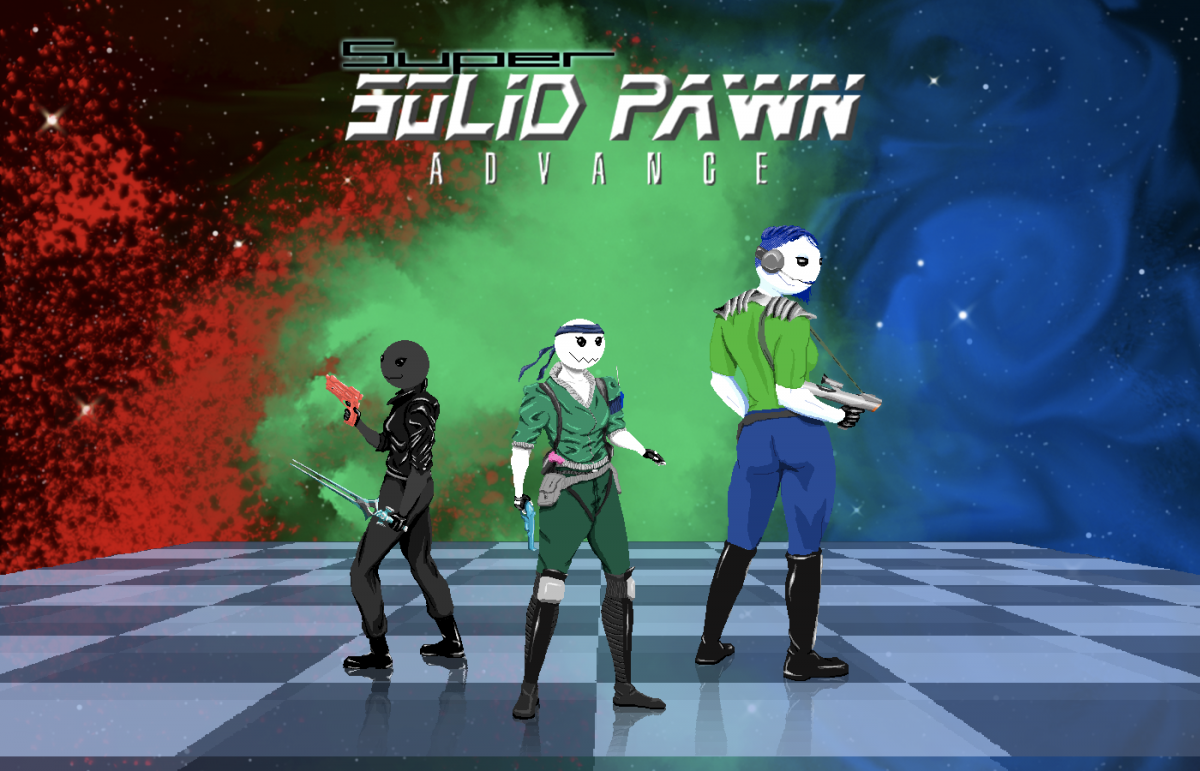Notice: Apologies for the delay in reviews this last month. Things should be moving at a steady pace once again with weekly Saturday reviews.
A book cover, movie poster, or game box art can say a lot about what you can expect from a product. It can also say absolutely nothing at all. While the old adage is true, you can’t judge a book by its cover, that won’t stop some covers from having an impact. A book cover can affect how you imagine the world described within, a movie poster can set your expectations for what you’re about to see, and sometimes a game’s box art can leave you utterly dumbfounded. Enter 1992’s The Lawnmower Man.
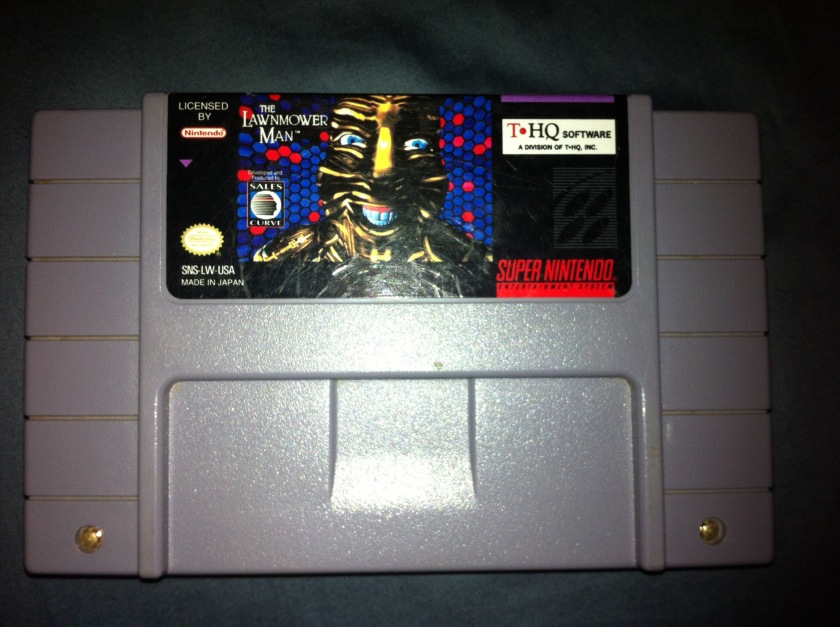
I came across this cart while looking through old games at a used bookstore. What could that title possibly have to do with that picture? What did this CG horror have to do with landscaping? At the risk of it turning out to be a gardening simulator, I bought it, and after doing a little research I found out what was up. The game is an adaptation of the ’92 film of the same name starring Pierce Brosnan and Jeff Fahey. The original box art even proclaims it to be a movie tie in game.
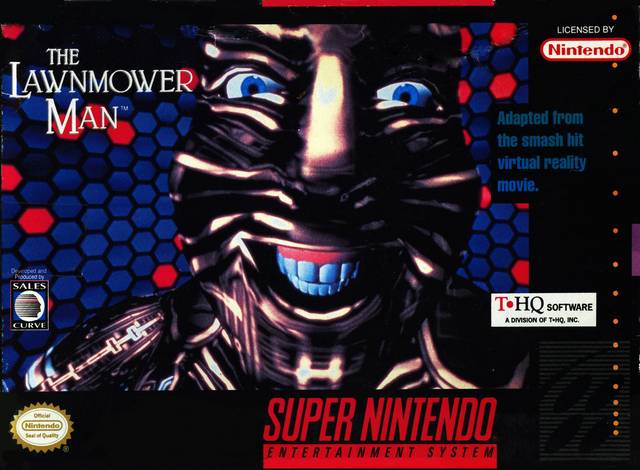
The movie is this weird combination of Daniel Keyes’ Flowers for Algernon and Stephen King’s Firestarter, and while the title is the same as one of King’s short stories, the film has basically nothing in common with it. Apparently, New Line Cinema owned a script called Cyber God, but they had little confidence in the project selling on its own. Since they also owned the film rights to King’s short story, they changed the name of their script and altered a few small details, intending to slap King’s name on the film to attract audiences. This lead to a couple of lawsuits as New Line kept trying to sneak King’s name on the project even though he had already won the suit to have it removed.
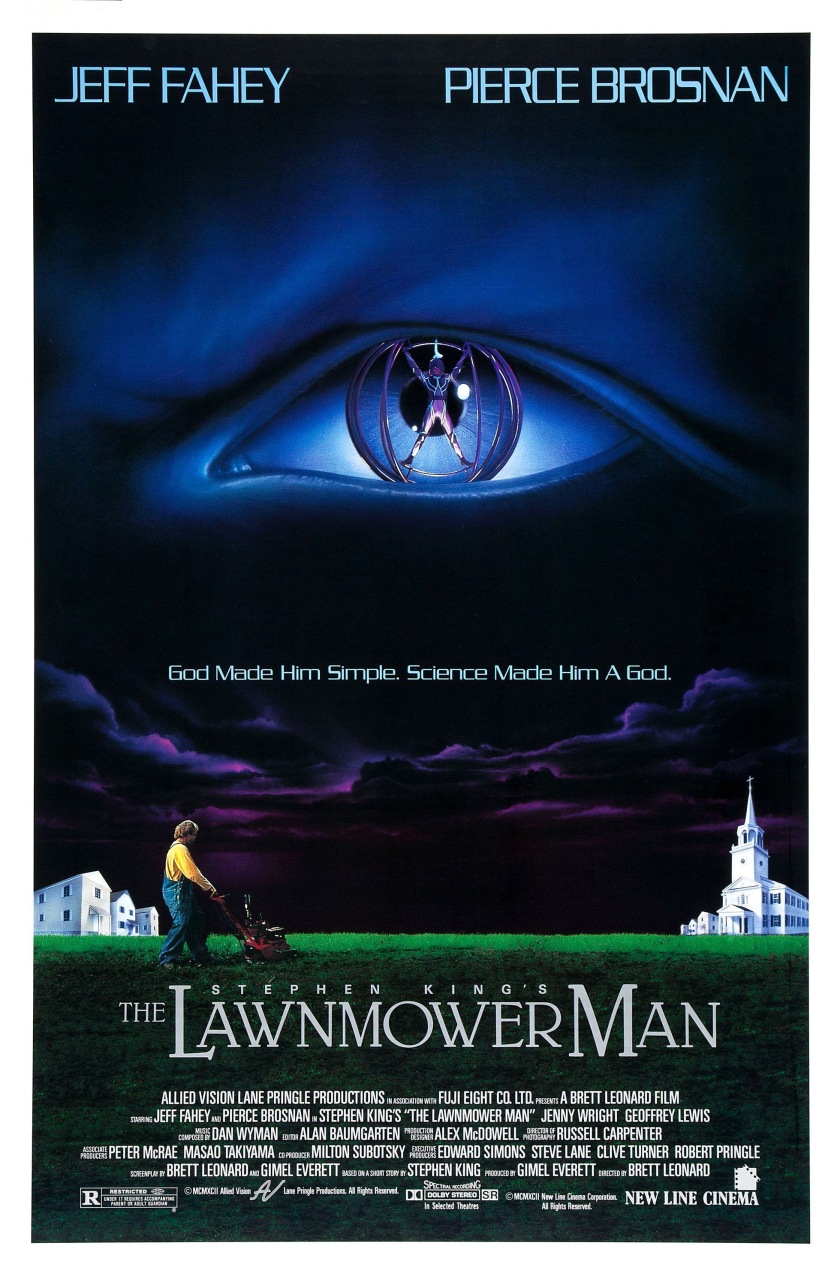
The video game made it to multiple consoles, however there are two different versions. The version released on PC, Mac, and the Sega CD is an FMV game in the vein of Dragon’s Lair where you input commands at specific points during a long movie to play. The version on the Super Nintendo is a combination of action platforming and shooting. A watered down version was also released on the Sega Genesis and Game Boy. For some reason, only the Nintendo versions had this freaky box art, which is actually a still from the movie’s climax.
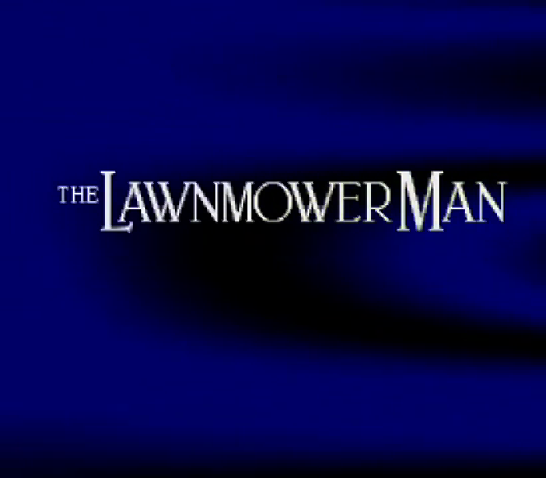
Story:
Dr. Lawrence Angelo has developed a method of increasing a person’s intelligence through the use of virtual reality and brain stimulating drugs. Angelo’s test subject is a developmentally challenged landscaper named Jobe. Through Angelo’s treatments, Jobe became hyper intelligent, and the procedures tapped into dormant abilities in the mind that gifted Jobe with psychic and telekinetic powers. The shady organization that funded Angelo’s research, The Shop, tampered with Jobe’s treatment, driving him towards madness. Jobe soon developed a god complex and, using his powers, melded his mind with The Shop’s supercomputers, increasing his powers exponentially, granting him control over the very fabric of reality. Now, Dr. Angelo must storm The Shop’s facilities, enter virtual reality, and stop Jobe from taking complete control of the world.
Since this is an action game, there isn’t much story content outside of the intro and the ending. The game takes place right near the end of the movie, when Jobe has entered cyberspace, and Angelo is going to the Virtual Space Industries building to stop him. About half way through the game, you fight Jobe and the end of the movie takes place, where he escapes into the Internet and takes control. Here, the game deviates from the film by having the world fall into World War III under Jobe’s influence. Some time later Dr. Angelo receives a message from Jobe, revealing that the leader of The Shop, known only as the Doom Player, was controlling his virtual consciousness. The rest of the game sees the player going to The Shop and back into cyberspace to defeat the Doom Player. Interestingly enough, the Sega Genesis version of the game does not include anything after defeating Jobe and ends at the halfway point of the SNES version.
All in all, the story is nothing to write home about, and it doesn’t have much bearing on the game.
Gameplay:
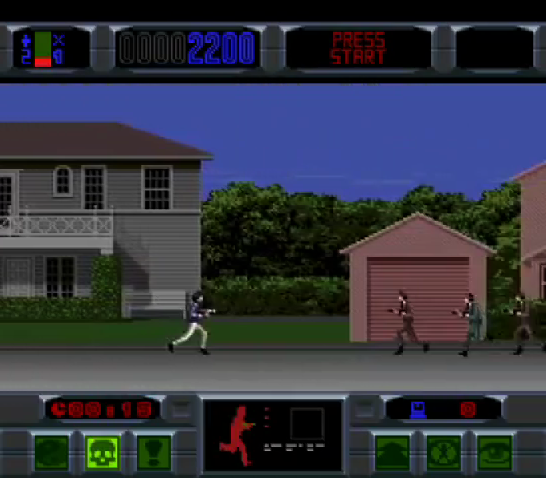
The Lawnmower Man’s levels are broken up into two main gameplay styles. Each level plays like a 2D shooter/action platformer, but placed throughout the levels are brief 3D sections based on the virtual reality games from the movie. The VR scenes connect the 2D segments and to complete a level, you must find a number of terminals scattered throughout the levels and destroy them by solving short puzzles.
The 2D gameplay is a little strange. It tries for a sort of Contra feel, since you basically run and gun, and a single hit can kill you. By destroying scenery, you can find weapon upgrades and data discs that fill a meter giving you a cyber interface suit that lets you take an extra hit. Killing enemies can potentially give you a score multiplier and a data boost, or weapon. When you get hit you lose all your data, and your weapon loses a power up. Although these parts seem straightforward in writing, in practice, they are somewhat hard to control. The run and gun gameplay is not as snappy as Contra. Your character isn’t as responsive and the erratic enemy movements and attacks result in a lot of unintended death. Part of the problem is the presentation, which uses a lot of mild colors and foreground imagery that blocks your field of view. These segments aren’t terrible, however they are more bearable on the Sega Genesis version, which uses larger character sprites, however that version has fewer levels overall.
The VR levels that connect the 2D segments are the game’s big selling point. They are basically a series of mini-games based around navigating obstacle courses. Some levels just have you flying through tunnels; others put you in a shooting gallery. There are two big levels in the game that are just long VR sections that connect larger stages. These levels are a bit of a challenge to get through because of their perspective and imprecise hit detection. Flying and shooting in first person prevents you from really knowing how close to a wall or enemy is too close, and although there are third person VR levels, it’s still pretty hard to avoid obstacles.
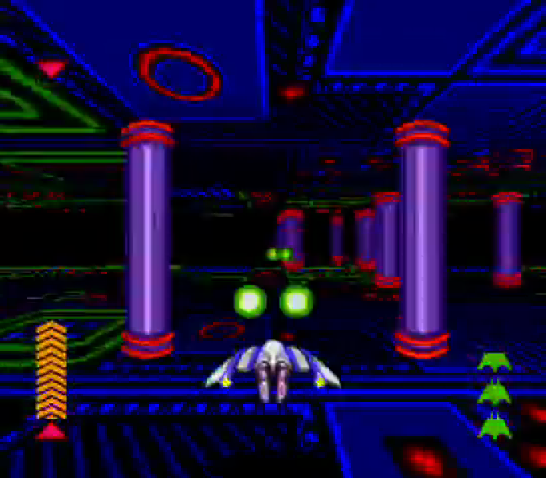
The game supports two player co-op, and at the start you have the choice to play as either Dr. Angelo or Carla Parkette, Rosalee Mayeux’s character in the film. Although there are no differences between the characters, it’s a nifty feature. Each player has their own lives and continues, and only one player can play the VR sections at a time, while the other watches. The only exception to this is the fight with Jobe where both players fight in a sort of Space Harrier style level.
Presentation:
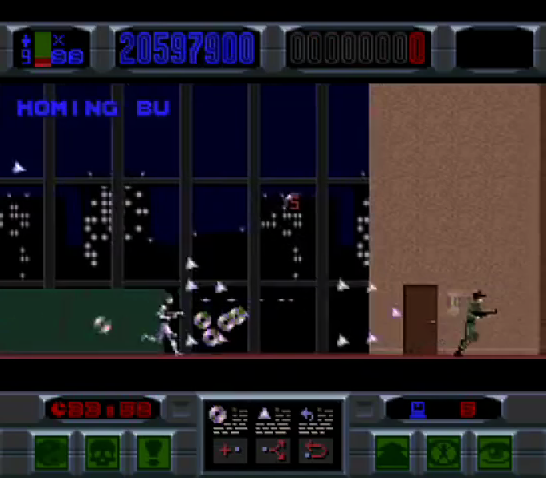
The graphics in the 2D segments are a little bland. They have some variety in terms of level design, but essentially they are just variations on suburban streets, warehouses, and office buildings. There’s nothing much that catches the eye. There are some details that are appreciated. The levels have small references to the film in them, mainly the names of some stores, or the design of a room or two, but on the whole, they aren’t that interesting to look at.
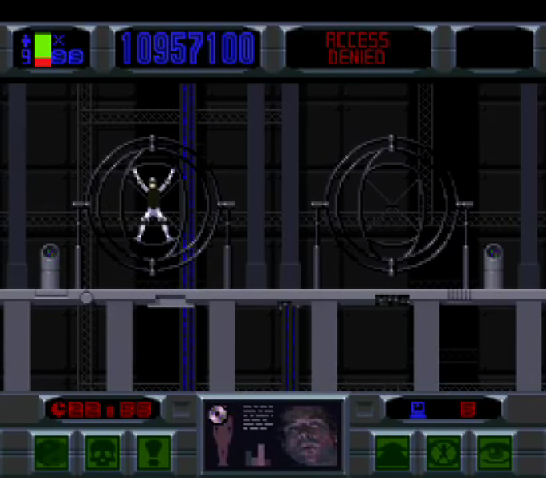
The most memorable parts of this game are the VR segments. It’s not very extensive 3D. The game does not use a Super FX chip like Star Fox or Doom, but it is still rather impressive for the time. There are no solid polygons, rather 2D scaling effects that give the illusion of 3D. There’s very little detail in these stages, usually just a series of flat single color passages, but they stand out and give the game variety. Interestingly, these stages are present in the Gameboy version as well, which is a rare sight on the handheld.
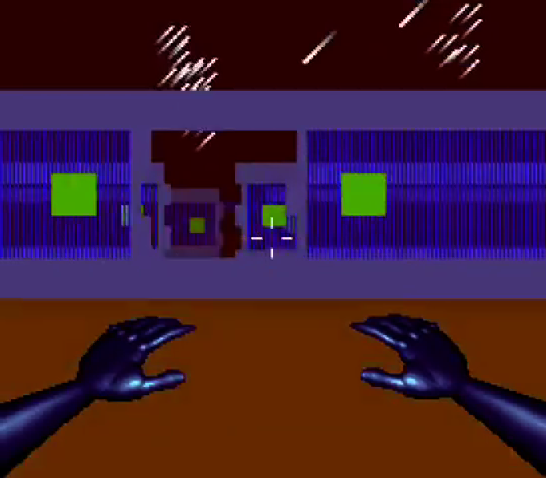
The music was composed by Allister Brimble across all versions, and on the Super Nintendo, it’s rather enjoyable. It’s soft electronica music with some ambient pieces that sound almost choral. Although the soundtrack is pretty good, it’s not particularly memorable. It’s not the kind of thing that would go down as a classic gaming score, but it’s fine for what it is, and there are not tracks that are particularly annoying. The sound design in the game overall is pretty quite and there are virtually no loud or obnoxious noises. It’s not really the kind of game to get you pumped for action, but the music is fitting for what it is.
Conclusion:
The Lawnmower Man was an interesting experience. I really didn’t know what to expect going in, but it turned out to be an alright side-scroller. I’m a huge fan of games that push the envelope on old systems, and although the main 2D parts of the game are just okay, the VR sections were rather impressive for the time this thing was made. The game has variety and shakes things up at a pretty steady pace. It is by no means a classic, but it is an interesting curiosity.
It’s interesting how the cover art to this game, is in fact representative of the product, if you are familiar with the film. This snapshot of Jobe’s virtual avatar is baffling to newcomers, however the other versions are not much farer, just a different image. Still, if the intention of the image was to make a passerby cringe, while at the same time hypnotically curious, it succeeded.
